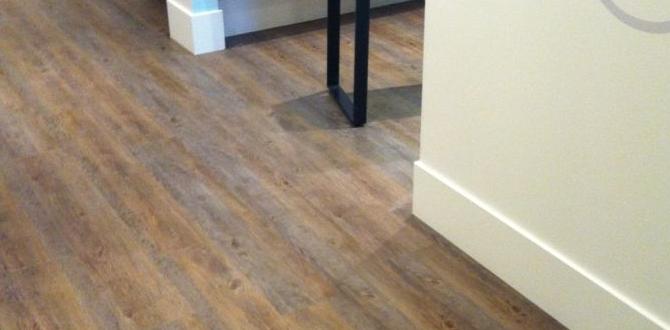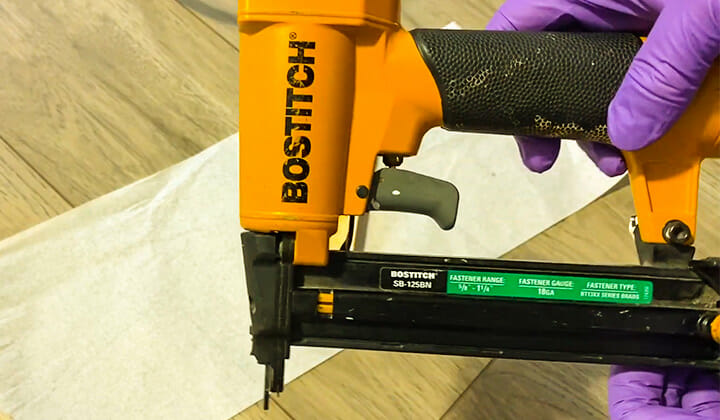Imagine walking into your home and feeling a warm, inviting vibe underfoot. For many, choosing the right flooring is about more than just looks; it’s about making smart choices for the planet. Have you ever wondered how eco-friendly wood flooring stacks up against vinyl? This decision can impact not just your home but also the environment.
Here’s a fun fact: wood flooring can be produced sustainably, while vinyl often comes from fossil fuels. That means your choices can help or hurt our Earth. Think about it—when you pick materials that are kind to the environment, you’re also building a better future. But what about costs and maintenance? Which option is easier on your wallet and your time?
In this article, we’ll explore eco-friendly wood flooring and vinyl. We’ll compare their benefits and drawbacks. By the end, you’ll know which is the best choice for your home and the planet. Let’s dive in and discover what flooring really suits you!
Table of Contents
Eco Friendly Wood Flooring Vs Vinyl: A Sustainable Comparison When It Comes To Choosing Flooring Options, The Debate Between Eco-Friendly Wood Flooring And Vinyl Has Gained Significant Attention. Both Choices Offer Unique Benefits And Drawbacks, Making The Decision A Challenging One For Homeowners And Builders Alike. In This Article, We Will Explore The Key Differences, Advantages, And Disadvantages Of Eco-Friendly Wood Flooring And Vinyl Flooring, Helping You Determine Which Option Aligns Best With Your Environmental Values And Aesthetic Preferences. Eco-Friendly Wood Flooring: The Natural Choice Eco-Friendly Wood Flooring Is Sourced From Sustainably Managed Forests. This Natural Material Not Only Provides Warmth And Beauty But Also Contributes To Better Indoor Air Quality. There Are Various Types Of Wood Flooring That Meet Eco-Friendly Standards, Such As Reclaimed Wood, Bamboo, And Fsc (Forest Stewardship Council) Certified Options. **Advantages Of Eco-Friendly Wood Flooring:** 1. **Sustainability**: Sourced From Responsibly Managed Forests Or Reclaimed Sources. 2. **Aesthetics**: Offers A Timeless Appeal That Enhances Home Value. 3. **Durability**: Can Last For Decades With Proper Maintenance. 4. **Air Quality**: Generally Free From Harmful Chemicals And Vocs (Volatile Organic Compounds). **Disadvantages Of Eco-Friendly Wood Flooring:** 1. **Cost**: Often More Expensive Than Vinyl Options. 2. **Maintenance**: Requires Regular Upkeep, Such As Refinishing. 3. **Moisture Sensitivity**: Can Warp Or Swell In High Humidity Areas. Vinyl Flooring: The Versatile Alternative Vinyl Flooring, Particularly Luxury Vinyl Planks (Lvp), Has Evolved Significantly Over The Years. This Synthetic Material Is Designed To Mimic The Appearance Of Wood While Offering Greater Durability And Water Resistance. **Advantages Of Vinyl Flooring:** 1. **Cost-Effective**: Generally Less Expensive Than Eco-Friendly Wood Options. 2. **Durability**: Highly Resistant To Scratches, Dents, And Moisture. 3. **Easy Installation**: Often Features Click-Lock Installation For Diy Projects. 4. **Variety**: Available In Numerous Designs, Colors, And Textures. **Disadvantages Of Vinyl Flooring:** 1. **Environmental Impact**: Made From Pvc, Which Can Raise Concerns About Sustainability. 2. **Limited Lifespan**: Generally Not As Durable As High-Quality Wood Flooring. 3. **Chemical Emissions**: May Contain Vocs, Impacting Indoor Air Quality Immediately After Installation. Making The Right Choice When Comparing Eco-Friendly Wood Flooring And Vinyl, Consider Your Priorities. If Sustainability And Natural Aesthetics Are Paramount, Eco-Friendly Wood Flooring Is Likely The Better Choice. However, If Budget, Durability, And Ease Of Maintenance Are Your Primary Concerns, Vinyl Flooring May Be The Way To Go. Ultimately, Each Option Has Its Unique Set Of Advantages And Disadvantages. By Evaluating Your Needs, Lifestyle, And Values, You Can Make An Informed Decision That Complements Both Your Home And Your Commitment To The Environment.

Eco-Friendly Wood Flooring vs Vinyl
Choosing between eco-friendly wood flooring and vinyl can be tricky. Wood flooring is natural and biodegradable, making it a sustainable choice. It brings warmth and elegance to your home. On the other hand, vinyl is cheaper and easier to install. However, it is made from synthetic materials and may not be as environmentally friendly. Did you know that vinyl production can create harmful chemicals? Opting for wood might be better for your health and the planet. Always consider your home’s needs when making a choice!Understanding Eco-Friendly Wood Flooring
Definition and characteristics of ecofriendly wood flooring. Types of sustainable wood sources and certifications.Eco-friendly wood flooring is a sustainable choice that combines beauty and responsibility. It comes from trees that are managed carefully to protect our planet. This kind of flooring often has certifications, like the Forest Stewardship Council (FSC), ensuring the wood is harvested responsibly. You can find sustainable options like bamboo, cork, or reclaimed wood. Each type gives your home a unique flair while being kind to nature. Plus, who wouldn’t want to walk on something that’s as green as a friendly frog?
| Type of Wood | Characteristics | Certification |
|---|---|---|
| Bamboo | Fast-growing, durable | FSC Certified |
| Cork | Soft, insulative | PEFC Certified |
| Reclaimed Wood | Unique, vintage look | Varies by source |
Benefits of Eco-Friendly Wood Flooring
Environmental advantages, including carbon footprint reduction. Health benefits associated with natural materials.Choosing eco-friendly wood flooring comes with some exciting perks! First, it helps reduce your carbon footprint. Trees absorb carbon dioxide, so using wood means less pollution in the air. Plus, these natural materials are healthier for you. Unlike vinyl, which can release chemicals, wood breathes and keeps your indoor air fresh. Who would have thought flooring could be this good for the planet and your health? Remember, every step on wood is like a high-five to Mother Nature!
| Benefits | Description |
|---|---|
| Carbon Footprint | Wood absorbs carbon dioxide, reducing air pollution. |
| Health | Natural materials mean fewer harmful chemicals indoors. |
Understanding Vinyl Flooring
Definition and characteristics of vinyl flooring. Types of vinyl flooring (e.g., LVT, WPC, SPC).Vinyl flooring is a popular choice for many homes. It’s made from synthetic materials, which gives it a flexible and durable nature. There are several types, like LVT (Luxury Vinyl Tile), WPC (Wood Plastic Composite), and SPC (Stone Plastic Composite). Fancy names, right? LVT has a beautiful design and feels great underfoot. WPC is thicker and great for wet areas. SPC is super tough, perfect for busy homes. Just think of it like the superhero of flooring!
| Type | Features |
|---|---|
| LVT | Stylish and soft |
| WPC | Water-resistant and sturdy |
| SPC | Highly durable and hard |
Benefits of Vinyl Flooring
Durability and resilience in various environments. Costeffectiveness and ease of installation.Vinyl flooring has many great benefits. It is tough and can handle spills, pets, and heavy foot traffic. This makes it perfect for busy homes. Installing vinyl is easy and quick, meaning you can enjoy your new floors sooner. Plus, it often costs less than other options like wood. This can save you money.
- Durability: Survives in many environments, from kitchens to playrooms.
- Cost-effective: Wallet-friendly, perfect for any budget.
- Easy installation: Simple enough for DIY projects.
What makes vinyl flooring a smart choice?
Vinyl flooring is smart because it is durable and affordable. It stands up well in busy areas and is easy to install.
Comparative Analysis: Eco-Friendly Wood Flooring vs Vinyl
Environmental impact and sustainability considerations. Cost comparison over initial purchase and longterm ownership.Choosing between eco-friendly wood flooring and vinyl can feel like picking between a cozy cat and a playful puppy! First up, wood flooring is a star in the sustainability game. It comes from trees and can be recycled, making it friendly for the Earth. Vinyl? It has a tougher time in nature’s recycling center, but it’s budget-friendly. On costs, wood flooring might burn a hole in your pocket initially, but it lasts long, making it your wallet’s best buddy over time. Here’s a fun comparison:
| Aspect | Eco-Friendly Wood Flooring | Vinyl Flooring |
|---|---|---|
| Environmental Impact | Recyclable and sustainable | Less eco-friendly |
| Initial Cost | Higher | Lower |
| Long-term Cost | Better durability | May need replacing sooner |
In the flooring world, wood is the fancy choice while vinyl is the easygoing friend. Both have their charm, but your home deserves a comfy and loving floor, don’t you think?
Aesthetic Considerations
Visual appeal and design versatility of both flooring types. Trends in home design involving wood and vinyl flooring.Choosing the right flooring can feel like choosing your favorite ice cream flavor—there are so many delicious options! Wood flooring offers a warm, natural beauty that adds character to any space. It brings the great outdoors inside. On the other hand, vinyl flooring shines with its flexibility. It comes in many styles and colors, mimicking wood, tile, or stone, all while being super durable. Both types are trending in design. Whether you love rustic charm or modern chic, there’s something for everyone!
| Flooring Type | Visual Appeal | Design Versatility |
|---|---|---|
| Wood Flooring | Warm, natural look | Classic styles, rustic vibes |
| Vinyl Flooring | Colorful and fun patterns | Countless styles, modern trends |
Maintenance and Longevity
Maintenance requirements for ecofriendly wood flooring. Maintenance requirements for vinyl flooring and longevity expectations.Taking care of eco-friendly wood flooring is like pampering a pet: it loves regular cleaning and a little love! You’ll need to sweep or vacuum it often to keep it happy and dust-free. A gentle mop with special wood cleaner will work wonders too! On the flip side, vinyl flooring is as low-maintenance as a sleeping cat. A quick mop or wipe with a damp cloth does the trick.
Now, about longevity: wood can last for decades if treated right. Think of it as a wise old tree. Vinyl, however, usually sticks around for about 10 to 20 years, unless it’s hit by a heavy chair or a sneaky pet claw!
| Flooring Type | Maintenance | Longevity |
|---|---|---|
| Eco-Friendly Wood | Regular cleaning, special wood cleaner | Decades with good care |
| Vinyl | Easy mop or wipe | 10-20 years, unless pets attack! |
Choosing the Right Option for Your Space
Factors to consider based on lifestyle and usage (e.g., family, pets). How to assess which material aligns with your ecofriendly goals.Choosing the best flooring for your home involves thinking about your life. Do you have children or pets? If yes, you may need a tougher floor. Consider these points:
- Durability: Will it last against scratches and spills?
- Comfort: Is it soft and warm for little feet?
- Maintenance: How easy is it to clean?
- Eco-Friendliness: Does it help our planet?
Look for options that fit your eco-friendly goals. Eco-friendly wood flooring offers natural beauty, while vinyl can be tough and stylish. Each choice has its own impact on the Earth.
What should I consider for eco-friendly flooring?
Think about your lifestyle and the floor’s impact on the environment. Durability and maintenance are key, especially with kids and pets. Eco-friendly choices can help you maintain a healthy planet at home.
Future Trends in Flooring Materials
Innovations in ecofriendly wood and vinyl technology. Market trends and consumer preferences shifting towards sustainability.New ideas are changing flooring. Eco-friendly wood and vinyl products are getting better. These materials are now made using less energy and resources. People want to use floors that are better for the Earth. More homeowners are choosing these greener options. Studies show that environmentally friendly choices can increase a home’s value. Sustainability is becoming a must in the flooring market.
What are current trends in flooring materials?
Trends include the use of recycled and sustainable materials. More buyers want products that don’t harm nature. Here are key points on what is popular:
- Use of bamboo and reclaimed wood.
- Vinyl with less harmful chemicals.
- Smart technology for easy maintenance.
- Stylish designs that mimic natural materials.
Conclusion
In summary, eco-friendly wood flooring is natural, sustainable, and often more durable. Vinyl, while cheaper and easy to clean, isn’t as environmentally friendly. You should think about what’s best for your home and the planet. Consider your budget and lifestyle needs. Explore more about both options to make a smart choice for your space!FAQs
What Are The Environmental Benefits Of Choosing Eco-Friendly Wood Flooring Over Vinyl Flooring?Choosing eco-friendly wood flooring is better for the Earth than vinyl flooring. Wood comes from trees, which help clean the air. It also breaks down naturally when we’re done with it. Vinyl, on the other hand, is made from plastic and can pollute the environment. By picking wood, we help keep our planet healthy!
How Do The Life Cycles And Sustainability Of Eco-Friendly Wood Flooring Compare To That Of Vinyl Flooring?Eco-friendly wood flooring comes from trees, which can grow back over time. This means it can be good for the environment if we manage it correctly. Vinyl flooring, on the other hand, is made from plastics and doesn’t break down easily. This makes it less friendly to nature. In the long run, eco-friendly wood is better for our planet than vinyl flooring.
What Are The Maintenance Requirements For Eco-Friendly Wood Flooring Versus Vinyl Flooring In Terms Of Environmental Impact?Eco-friendly wood flooring needs careful cleaning and can be damaged by water. You can use a damp mop and gentle soap. This helps keep the wood strong and lasts longer. Vinyl flooring is easier to clean and needs less care, which means less waste and fewer resources used. Overall, taking care of wood floors can be better for the environment if done right.
How Do The Durability And Lifespan Of Eco-Friendly Wood Flooring Compare To Vinyl Options, And What Implications Does This Have For Environmental Sustainability?Eco-friendly wood flooring usually lasts longer than vinyl flooring. It can last up to 50 years, while vinyl may only last 10 to 20 years. This means we need to replace vinyl more often, which creates more waste. Using longer-lasting wood helps keep our environment cleaner. So, choosing wood can be better for the planet!
What Certifications Should Consumers Look For When Selecting Eco-Friendly Wood Flooring To Ensure It Is Truly Sustainable Compared To Vinyl Alternatives?When choosing eco-friendly wood flooring, look for the Forest Stewardship Council (FSC) label. This shows the wood comes from well-managed forests. You can also check for the Sustainable Forestry Initiative (SFI) seal. This means the wood is sourced responsibly. These labels help ensure the flooring is better for the Earth than vinyl options.





